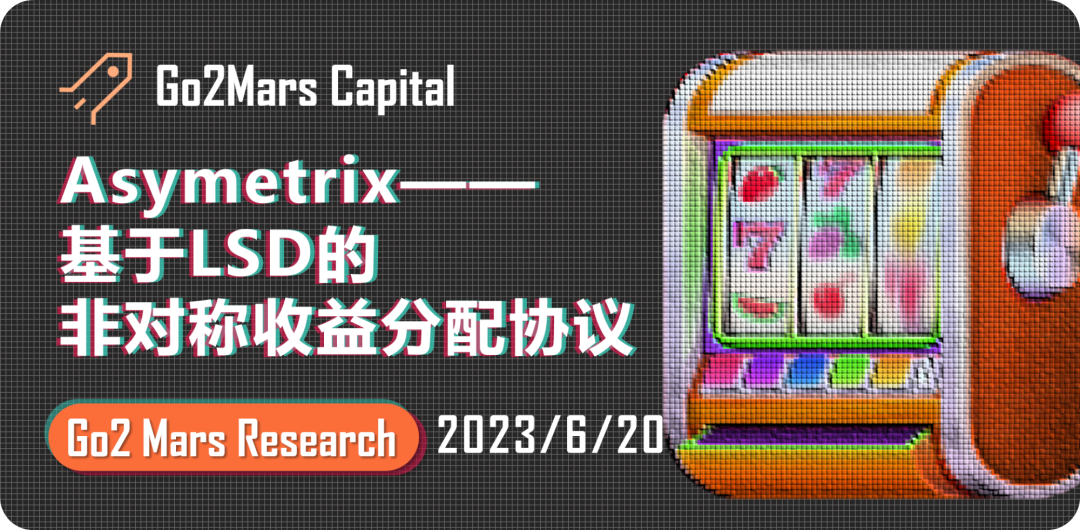Analysis of Asymetrix: An LSD-based Asymmetric Profit Distribution Protocol
Asymetrix Analysis: An LSD-based Protocol for Uneven Profit DistributionFor individual investors with limited funds, the annual return on ETH staking is generally only about 5%, which is difficult to stimulate their investment interest. They often enter the cryptocurrency market in search of higher returns. Asymetrix provides them with an opportunity to concentrate all stakers’ earnings and distribute them to a few lucky ones through a fair and transparent mechanism, allowing them to earn excess returns, while other stakers only break even and do not receive any returns.

How the protocol works
- Users deposit staked ETH (stETH) into a public pool supported by smart contracts. Once a user deposits to the Asymetrix protocol, the smart contract mints PST (Pool Share Token) in a 1:1 ratio and sends it to the user’s wallet. PST tokens reflect the user’s share in the protocol and are necessary for withdrawals. In the current version of the protocol, the minimum deposit amount is 0.1 stETH. However, the deposit does not necessarily have to be a multiple of 0.1 stETH (i.e. 0.11234 stETH is acceptable).
- The public pool generates earnings once every 24 hours; the earnings generated by the pool are distributed to the participants of the protocol randomly and asymmetrically on a regular basis (currently once a week);
- Based on the proportion that a user holds in the protocol’s TVL, all users will receive ASX token rewards as initial distribution.
- In the case of a win, users will automatically receive rewards in the form of PST (equivalent to the amount of stETH), so their balance will increase, which will automatically increase the chances of further lottery draws. Therefore, it is not necessary to claim the reward every time. It will be executed automatically.
Calculation of winning probability
Since the protocol accumulates earnings over time, a basic indicator is the length of time a user’s stETH has been in the pool and how much earnings it has generated for the protocol. Otherwise, crypto whales may make large deposits into the protocol at the last minute, obtaining huge odds and “stealing” earnings from small users.
Therefore, the first indicator that affects odds is TWAB (Time Weighted Average Balance). This indicator shows the user’s contribution to the total pool earnings generated between lottery draws. If the interval between two lottery draws is one week, and a user stakes 100 stETH in the pool for one week (i.e. 100% of the time), then its TWAB value is 100. The TWAB value determines the number of lottery tickets held by the user. The total number of tickets is the sum of all users’ TWAB values divided by the minimum deposit amount, rounded down. Users will receive the corresponding number of tickets based on the proportion of their TWAB value to the total value, and all tickets will be hashed to obtain a unique ID. The protocol sends a request to Chainlink VRF for a random number, and the returned random number is moduloed to ensure that it is within the range of ticket numbers. Once a matching random number appears, it is matched with the list of tickets to select the winner.
- Circle’s 15 potential projects to watch in 2023
- Perform data analysis and comparison for the (3,3) section projects, bribery efficiency ranks as follows: Thena > Velo > Chronos > Pearl.
- New Project Preview | LSDFi: Lucid Finance to Assist Emerging LST Protocol in Gaining Liquidity
Governance
The protocol uses AXS tokens as a governance token, allowing users to participate in the governance process by holding AXS tokens. Users can propose and vote on various parameters and strategies that affect the protocol’s operations and performance. For example, users can decide how many users will receive a share of the earnings in the weekly lottery, how the earnings will be distributed among them, how the protocol’s funds will be managed and allocated, and what other features or improvements should be implemented in the protocol.
Token Value Capture
AXS token is meant to be the governance token of the Asymetrix protocol and a tool to capture the protocol’s growth value. However, from the current documentation, the protocol does not have a clear business model or fee structure, nor does it charge any fees from the revenue generated by the protocol. This means that all the profits from the protocol revenue distribution go to the users who deposit stETH into the protocol, and AXS token holders do not receive any rewards or dividends from the protocol’s income. This also means that there is no strong demand or utility for AXS tokens in the protocol, and their value is entirely dependent on speculation or governance participation.
Summary

The protocol allows people who hold a small amount of ETH to enter the exciting LSDfi world, where they can enjoy high returns and randomness through asymmetric profit distribution. The protocol is also easy to use, as users only need to deposit stETH into the smart contract and wait for the weekly lottery. However, there is still a lot of room for improvement in the token economics design of the protocol, as AXS tokens do not have a clear value proposition or incentive mechanism to align the interests of users, developers, and governance participants.
We will continue to update Blocking; if you have any questions or suggestions, please contact us!
Was this article helpful?
93 out of 132 found this helpful
Related articles
- Exploring the Ethereum Layer2 network Fraxchain
- New Project Preview | Artichoke Provides a Unidirectional Liquidity Layer DeFi Protocol
- Quick Overview of Five Projects Recently Incubated and Invested by Binance Labs
- Winning projects from hackathons hosted by Delphi Labs and Cosmos ecosystem
- Inventory of 6 encryption projects joined in NVIDIA Inception program
- Will the introduction of “staking mining” on BRC-20S mark the beginning of Bitcoin DeFi summer?
- Hidden Gems in the Crypto World: A Review of Web3 Gaming Projects






